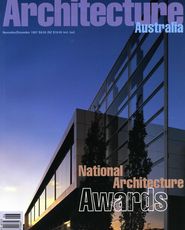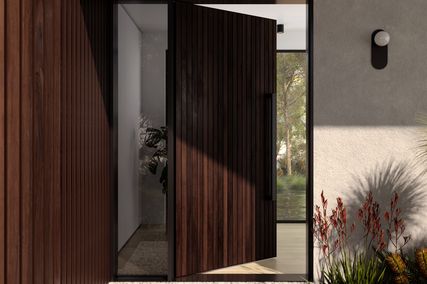| ||
| Architecture in Transition: The Sulman Award 1932-1996 By Andrew Metcalf, published by the Historic Houses Trust of NSW, $40.
If you want to learn how the future of cities is fast coming to get us, this stratospherically priced (presumably for academic libraries) compilation of 36 international essays offers what chefs might call a degustation menu of scenarios. Although several texts have been published before, some theories now seem a bit dodgy and one or two papers are doggedly technical, there are more than 20 first-rate reads on how telecommunications technologies are likely to transform urban places, metropolitan systems, cultures and lives. As an assistant to the editor, I was intimate with every word of this tome—and highly rate the chapters by Saskia Sassen on the economics of global cities, Marie-Christine Boyer on technology’s impacts on the public psyche, Martin Pawley on ‘stealth’ architecture, Jeffrey Rayport and John Sviolka on marketing via the internet, Michael Ostwald on the ‘arborescent’ hierarchies of virtual space, Marcos Novak and Alan Bowen-James taking different positions on the meaning of intelligent environments, Michael Heim recalling his immersion in virtual space, Bill Hillier on his ‘spatial syntax’ maps to predict where people will walk in public spaces, Scott McQuire on unhomely homes, Bill Seaman on art in the virtual world, Peter Marcuse’s sceptical dismissal of the ethics concealed in globalisation and, indeed, Peter Droege’s introductory text finishing with a worthy list of to-dos. |  Francis Greenway Architect Francis Greenway ArchitectEdited by James Broadbent and Joy Hughes, published by the Historic Houses Trust of NSW, $35. This book begins with a somewhat hysterical ode to the nobility of a petty forger who became Australia’s first architect. A sample from the first paragraph: “Receiving the gift of Architecture from the goddess Minerva, he offered it to the philistines in a remote penal colony, and they gave him free coals …” Fortunately, the authors promptly get real to construct a balanced review of of a talented, though not exceptional, practitioner who also had that particular screw loose which turns some architects into vicious nasties as far as their peers are concerned. This volume offers many colourful anecdotes and sub-plots from a turbulent life in two countries. It also includes reports on all buildings known to have been designed by Greenway, plus some where authors could be others. It appears that our man often campaigned to usurp rivals by furnishing their clients with claims of incompetence—and the profession shunned him for it.
Dull topic? If you’re not interested in the history of home furnishings, this catalogue won’t appeal. But those who are curious to learn about domestic life in Australia over the first 150 years of white settlement will find Scott Carlin’s concise survey, prepared for an exhibition at Sydney’s Hyde Park Barracks, illuminating and good value. There is no tale here: it’s a simple chronicle of the diverse materials—colonial oil cloths, rag rugs, early printed linoleums, Oriental carpets and English-made Axminsters—marketed to middle-class homeowners to lay on their floors. There are excellent instructions for making an earth slab that “gleams, black, polished like a board”, and many period quotes on how to keep floorcoverings clean. |

 Given miserly time to produce a catalogue of exceptional import to Sydney’s architectural culture, Andrew Metcalf has done the trick. This retrospective on the RAIA’s top NSW award—the Sir John Sulman Medal for Public Buildings, introduced in 1932—comes from a Canberra architect who was in the front line of Sydney debate—as a theorist, practitioner and events arranger—during the 1980s. Although provided with much basic research from the architects who prepared the exhibition, Metcalf has infused the facts with assured interpretations that lift the work to a much more interesting level than is usual for retrospective documents published by museums. He appears to recognise what many critics resist: that all architectural acts are political performances arising from emotional instincts and subjective ‘logic’. On that basis, he unfolds a terrific saga about how Sydney architects have built a common mentality, as well as a public realm, over the last 65 years. Regrettably, his words are dulled by the book’s design: to spark up a one-colour format, splashy bands of blue subsume text in reticent typefaces
Given miserly time to produce a catalogue of exceptional import to Sydney’s architectural culture, Andrew Metcalf has done the trick. This retrospective on the RAIA’s top NSW award—the Sir John Sulman Medal for Public Buildings, introduced in 1932—comes from a Canberra architect who was in the front line of Sydney debate—as a theorist, practitioner and events arranger—during the 1980s. Although provided with much basic research from the architects who prepared the exhibition, Metcalf has infused the facts with assured interpretations that lift the work to a much more interesting level than is usual for retrospective documents published by museums. He appears to recognise what many critics resist: that all architectural acts are political performances arising from emotional instincts and subjective ‘logic’. On that basis, he unfolds a terrific saga about how Sydney architects have built a common mentality, as well as a public realm, over the last 65 years. Regrettably, his words are dulled by the book’s design: to spark up a one-colour format, splashy bands of blue subsume text in reticent typefaces Born and educated in Melbourne, employed by architects in Canberra and Darwin, James Birrell settled in Brisbane in 1955 to forge a career in two public architectural offices: first at the Brisbane City Council and later at the University of Queensland. In this concise, wax-finished firmcover, collaborators in Melbourne (young practitioner Andrew Wilson) and Brisbane (UQ scholar John Macarthur) have put together a modest ‘this is your life’ information pack on a local hero of modernism who responded to the sculptural gestures of Oscar Neimeyer, Barbara Hepworth and Hans Arp. A miscellany of old photographs and diagrams lend the sense of a scrapbook. Key texts have been written by Philip Goad and Macarthur with Shane Murray but special interest lies in the interviews with Birrell himself.
Born and educated in Melbourne, employed by architects in Canberra and Darwin, James Birrell settled in Brisbane in 1955 to forge a career in two public architectural offices: first at the Brisbane City Council and later at the University of Queensland. In this concise, wax-finished firmcover, collaborators in Melbourne (young practitioner Andrew Wilson) and Brisbane (UQ scholar John Macarthur) have put together a modest ‘this is your life’ information pack on a local hero of modernism who responded to the sculptural gestures of Oscar Neimeyer, Barbara Hepworth and Hans Arp. A miscellany of old photographs and diagrams lend the sense of a scrapbook. Key texts have been written by Philip Goad and Macarthur with Shane Murray but special interest lies in the interviews with Birrell himself.













